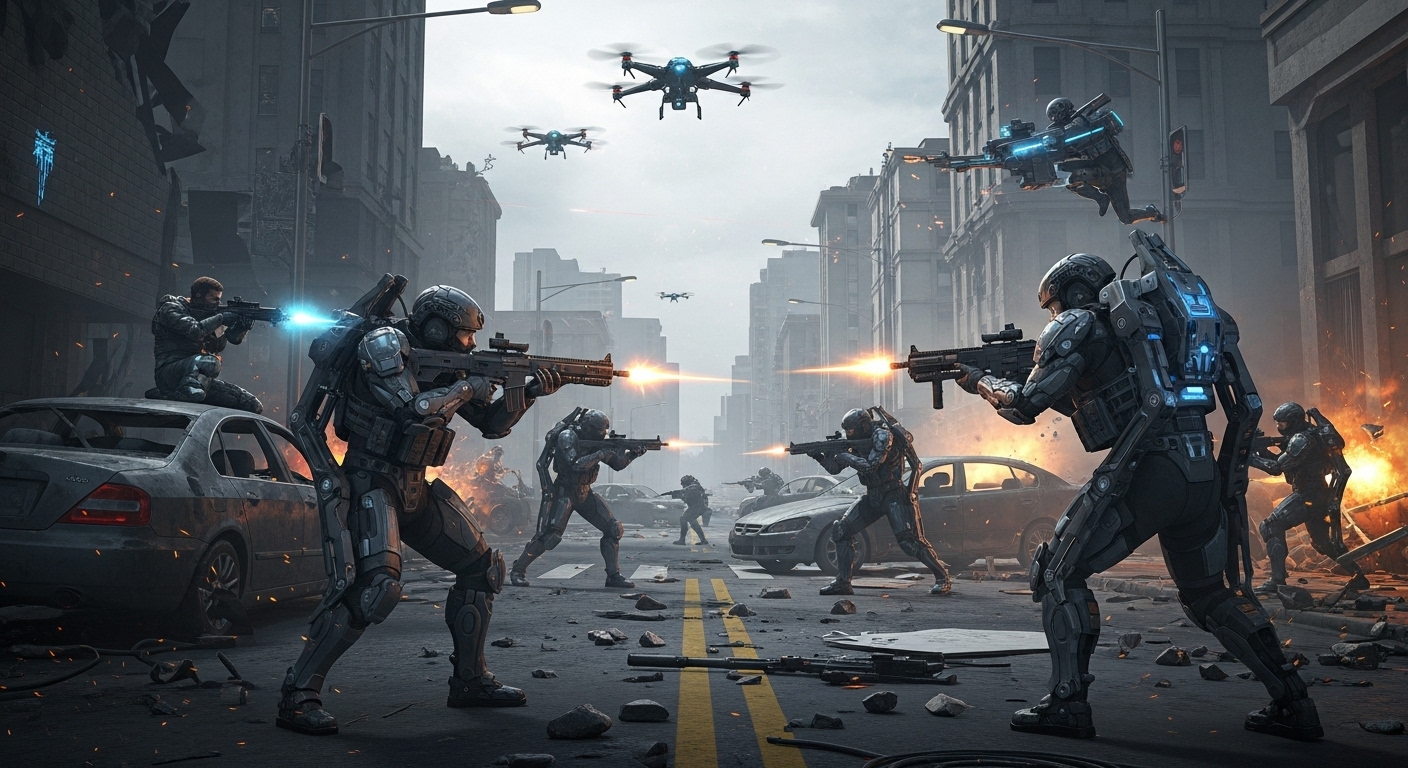“Combat” encapsulates a complex tapestry of human experience: the thrilling, stylized spectacle seen in entertainment and the brutal, often devastating reality of armed confrontation. At its core, it’s a direct, physical struggle between opposing forces, constantly redefined by technological innovation, evolving tactics, and a deepening understanding of its profound human toll. As of mid-2025, the nature of combat is undergoing a transformative shift, driven by breakthroughs in AI, robotics, and cyber capabilities.
The Duality of Conflict: Controlled Arenas vs. Unforgiving Battlefields
The term “combat” carries distinct meanings depending on its context:
- In Entertainment & Sport (Simulated/Controlled Combat): This is the most common encounter with combat for many. It encompasses meticulously choreographed sequences in action films, strategic maneuvers in video games (like FPS or fighting games), or the formalized rules of martial arts competitions and combat sports. Here, combat is designed to:
- Thrill and Excite: High stakes, displays of extraordinary skill, and unpredictable outcomes create compelling spectacles.
- Showcase Prowess: Highlight the physical, mental, or strategic capabilities of fictional characters or real-world athletes.
- Advance Narrative: Drive plots forward, create character arcs, and resolve conflicts in a structured way.
- Provide Catharsis: Allow audiences to experience danger and triumph vicariously, in a safe and controlled environment.
- Examples: Mixed Martial Arts (MMA) events like the UFC, professional boxing, wrestling, traditional martial arts demonstrations, and the latest fighting video games. The global combat sports products market is projected for strong growth, reaching $9.54 billion in 2025, fueled by rising participation and media coverage.
- In Reality (Actual Combat): This refers to real-world armed conflict, self-defense situations, or law enforcement engagements. This type of fighting is characterized by:
- Extreme Danger: The constant, life-threatening risk of injury, severe harm, and fatality.
- Unpredictability and Chaos: Despite meticulous planning, real combat is fluid and chaotic, with unforeseen variables.
- Profound Consequences: Beyond immediate physical injuries, real combat leaves deep, long-term psychological scars (such as Post-Traumatic Stress Disorder – PTSD, depression, anxiety), leads to loss of life, and causes widespread devastation to infrastructure and communities.
- Moral and Ethical Dilemmas: Combatants often face difficult, high-stakes choices with profound ethical implications under extreme pressure.
A Legacy of Adaptation: The Evolution of Fighting
The methods and nature of fighting have evolved constantly alongside human technological and societal development:
- Ancient & Traditional Forms: From rudimentary weapons like clubs and spears, to the highly formalized martial arts of ancient civilizations (e.g., Kung Fu, Karate, Muay Thai), emphasizing both combat effectiveness and philosophical discipline.
- Organized Warfare: The rise of organized armies, fortifications, and sophisticated tactics, leading to large-scale battles in ancient and medieval eras.
- Modern Warfare: The 20th and 21st centuries have seen the advent of air power, armored vehicles, precision-guided munitions, and advanced intelligence gathering. This has transformed the scale, speed, and lethality of conflict.
Trends in Combat in 2025: From AI Dominance to Human Augmentation
As of mid-2025, the world of combat – both real and simulated – is shaped by several key trends:
In Real-World Conflict:
- AI Integration and Robotic Warfare: Artificial intelligence is no longer a theoretical concept but a crucial part of military operations. AI-powered warfare solutions enhance decision-making, improve surveillance capabilities, and optimize electronic warfare strategies. The 2025 Israel–Iran war, for instance, marked a historic milestone as the first large-scale conflict where AI was indispensable for battlefield operations, from intelligence and targeting to strike execution, accelerating the tempo and precision of attacks. Uncrewed Aerial Vehicles (UAVs) and ground robots are increasingly deployed for reconnaissance, logistics, and high-risk combat missions, sometimes operating with reduced human dependence. Swarms of networked drones, enabled by distributed AI, can adapt and react as a group, presenting an overwhelming force. The global AI in military market is projected for substantial growth from 2025 to 2030, with significant investments from nations like the US and China.
- Cyber Warfare Escalation: Cybersecurity remains a critical defense priority. Unified cyber defense platforms, integrating AI detection systems and blockchain protection, are being deployed to defend classified information and critical infrastructure against sophisticated cyber attacks from state-sponsored hackers. Cyber operations are increasingly used to spread disinformation and destabilize adversaries. The global cybersecurity market is seeing increasing demand due to geopolitical tensions and reliance on digital infrastructure.
- Directed Energy Weapons (DEWs): Militaries are actively deploying laser-based systems for air and missile defense, as well as for countering drones. DEWs offer cost-effective, highly accurate, and virtually endless “ammunition,” making them a cornerstone of future combat strategies.
- Hypersonic Weapons: These weapons, capable of traveling at speeds exceeding Mach 5, are redefining modern warfare by striking targets with unparalleled speed and precision, challenging traditional defense systems. Several nations are expected to further develop and deploy hypersonic missiles by 2025, intensifying a new arms race.
- Biotechnology and Human Augmentation: Research continues into enhancing soldier performance and resilience through biotechnology, including wearable tech for monitoring vital signs and cognitive states, and potential human augmentation to improve physical and mental capabilities.
- Immersive Training Technologies: Augmented Reality (AR) is becoming a standard tool for immersive training simulations, providing soldiers with enhanced situational awareness and realistic combat scenarios. VR-enabled combat simulations offer risk-free environments for practicing complex operations, tailored to individual soldier’s learning paces.
In Entertainment and Sports:
- Hyper-Realistic Choreography: Action films and video games are pushing the boundaries of realism in combat. This involves a seamless blend of practical stunts and cutting-edge CGI, with a focus on believable physics and character reactions. Franchises like John Wick continue to set the standard for intricate and impactful fight sequences.
- AI-Assisted Creation: AI tools are increasingly used in pre-visualization, special effects, and even in choreographing complex combat sequences for film and game development, allowing for more ambitious and fluid action.
- Growing Popularity of Combat Sports: MMA continues its surge in popularity, driving interest in various martial arts. The UFC remains a dominant force, pursuing global expansion and blockbuster matchups. New formats like “Dirty Boxing” are emerging, blending boxing and clinch work for nonstop action. Bare-knuckle fighting, with celebrity involvement (e.g., Conor McGregor in BKFC), is also seeing significant growth, appealing to fans of raw combat. Hybrid training programs, blending multiple disciplines like Muay Thai, Brazilian Jiu-Jitsu, and Krav Maga, are becoming mainstream, offering more well-rounded skill sets for competition and self-defense.
- Women in Combat Sports: The rise of women in martial arts and combat sports is a significant trend, with disciplines like Krav Maga and Brazilian Jiu-Jitsu seeing increased female participation and dedicated women-only classes, empowering female athletes globally. The PFL (Professional Fighters League) is expanding into Africa, creating new opportunities for female fighters and driving the sport’s growth in new territories.
The Psychology and Societal Impact
Fighting, whether in a controlled environment or a real-world scenario, has profound psychological implications. Participants in real combat face significant risks of PTSD, depression, and anxiety, impacting their long-term mental health. Studies in 2025 continue to explore the complex structure of combatant stress, with factors like sustained enemy offensive activity and lack of resources contributing to psychological toll. Mental health support for combat veterans remains a critical global priority.
Societally, fighting in sports provides a controlled outlet for aggression and a powerful spectacle of human achievement. It fosters communities, builds national pride during international competitions, and serves as a testament to the discipline and dedication of athletes. The narrative of overcoming adversity inherent in fighting resonates deeply across cultures.
While the simulated world of entertainment provides a safe space to explore the excitement and drama of conflict, it’s crucial to remember that real-world combat remains a grim and complex reality. Understanding both its allure in fiction and its devastating impact in life is essential for a comprehensive view of this ever-evolving aspect of the human experience.

